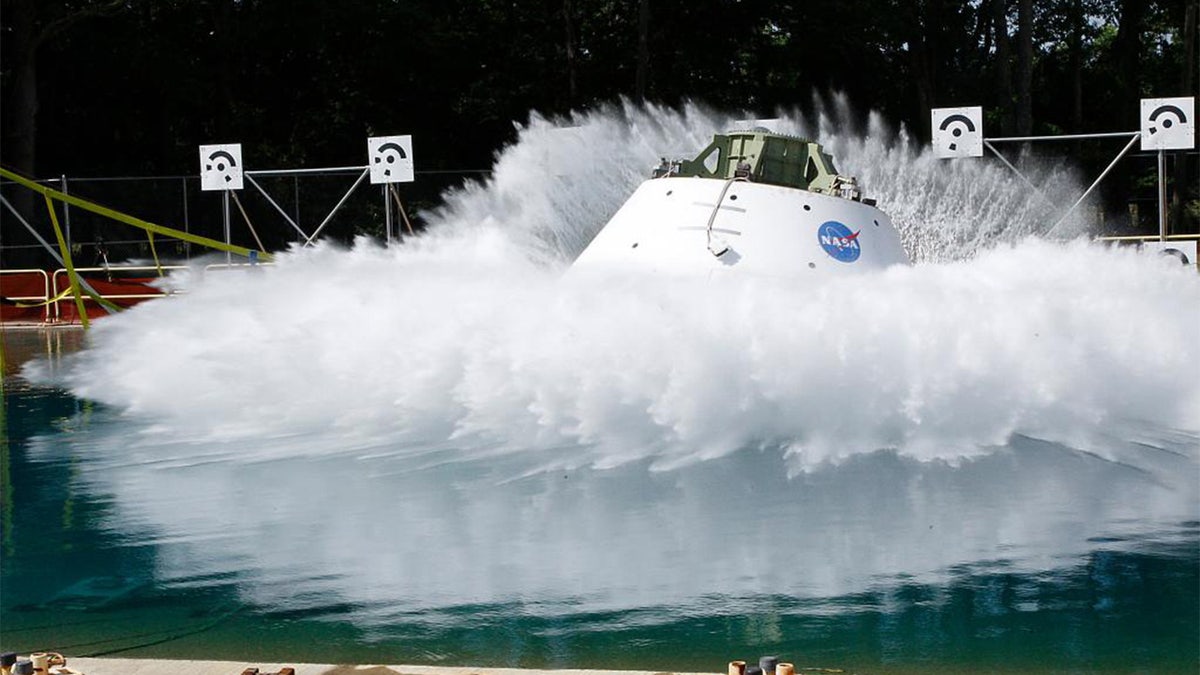NASA rocket passes key test for Artemis mission
Acting NASA Administrator Steve Jurczyk provides insight on ‘FOX News Live.’
NASA engineers at the Virginia-based Langley Research Center have begun a new series of four water-impact drop tests using a test version of the agency's Orion spacecraft capsule.
NASA GIVES ALL CLEAR: EARTH SAFE FROM ASTEROID THREATS FOR 100 YEARS
The tests, conducted at Langley's Landing and Impact Research Facility Hydro Impact Basin in Hampton, will simulate various landing scenarios in order to help researchers get a clearer picture of what Orion and its crew may experience when landing in the Pacific Ocean after the planned Artemis missions to the moon.

(NASA)
Orion will launch on NASA's new heavy-lift rocket, the 322-foot-tall Space Launch System (SLS), which is set to be used in Artemis I at the end of the year.

The first drop test for the latest Orion model capsule of March 23, 2021. Testing was done from the height of 18 inches in splash impact basin at NASA Langley. (NASA)
During the first Artemis mission, the SLS rocket will send an uncrewed Orion on a flight around the lunar planet and back to Earth -- marking the first of three missions.
NASA plans to land the first woman and next man on the moon by 2024 in order to "explore more of the lunar surface than ever before" and prepare for the next step: sending astronauts to Mars.
While engineers officially started testing with a rough model of Orion in 2011, NASA had performed a series of previous drop tests with what they called a Ground Test Article at the basin in 2016.
NASA PREVIEWS FIRST MARS HELICOPTER FLIGHTS: EVERY STEP TAKEN IS 'UNCHARTED TERRITORY'
However, the new tests are using a new configuration of the crew module -- built at lead contractor Lockheed Martin’s facility in Colorado -- that "represents the spacecraft’s final design," according to a release.
"Data from the water impact tests are part of the formal qualification test program to fulfill structural design and requirement verification before Artemis II, NASA’s first Artemis mission with crew," NASA wrote. "Information will help feed final computer models for loads and structures prior to the Artemis II flight test."
In a previous statement, NASA wrote that there had been several structural updates and improvements to the crew module and noted that data from the 2021 tests would be included in final computer modeling.
CLICK HERE FOR THE FOX NEWS APP
"This is less about trying to reduce model uncertainty and more about loading up to design limits, bringing the model higher in elevation and higher in load, not testing to requirements, but testing to extremes," Chris Tarkenton, technical lead, explained in November.
"Thousands of possibilities will be whittled down to some critical cases. We’ll examine the data and make sure the models correlate to test and adjust models as needed to gain confidence," Project Manager Bryan Russ said. "It helps us to know that the models are reliable and representative of what will be experienced during flight scenarios."





















